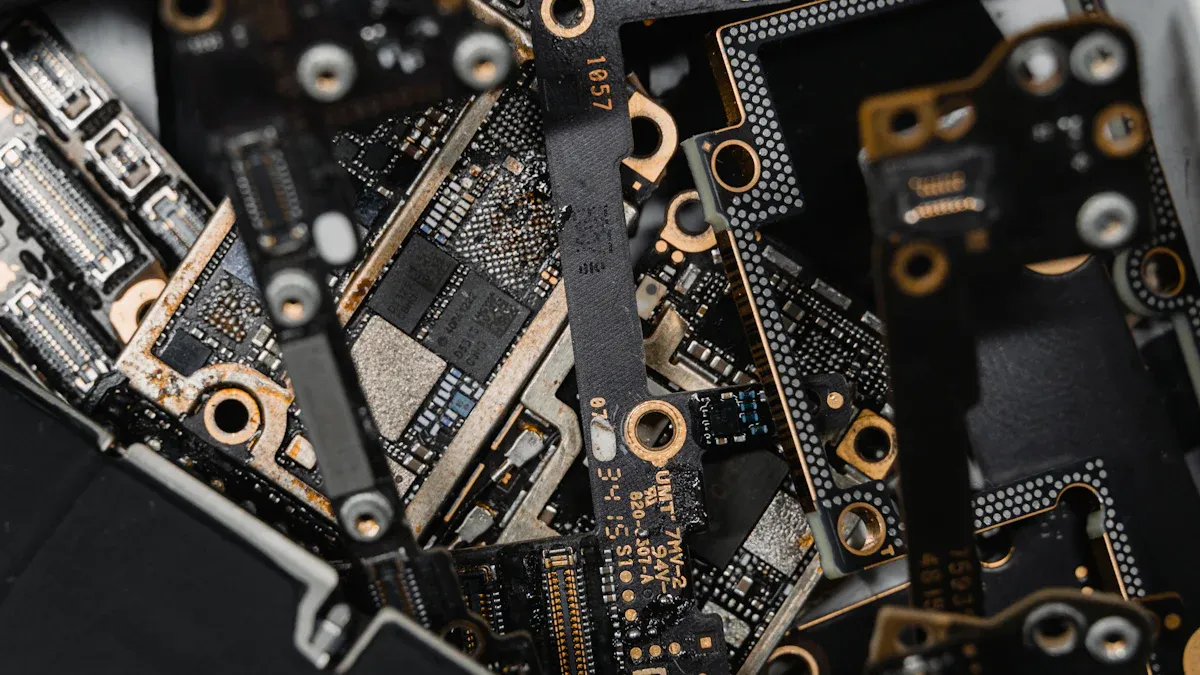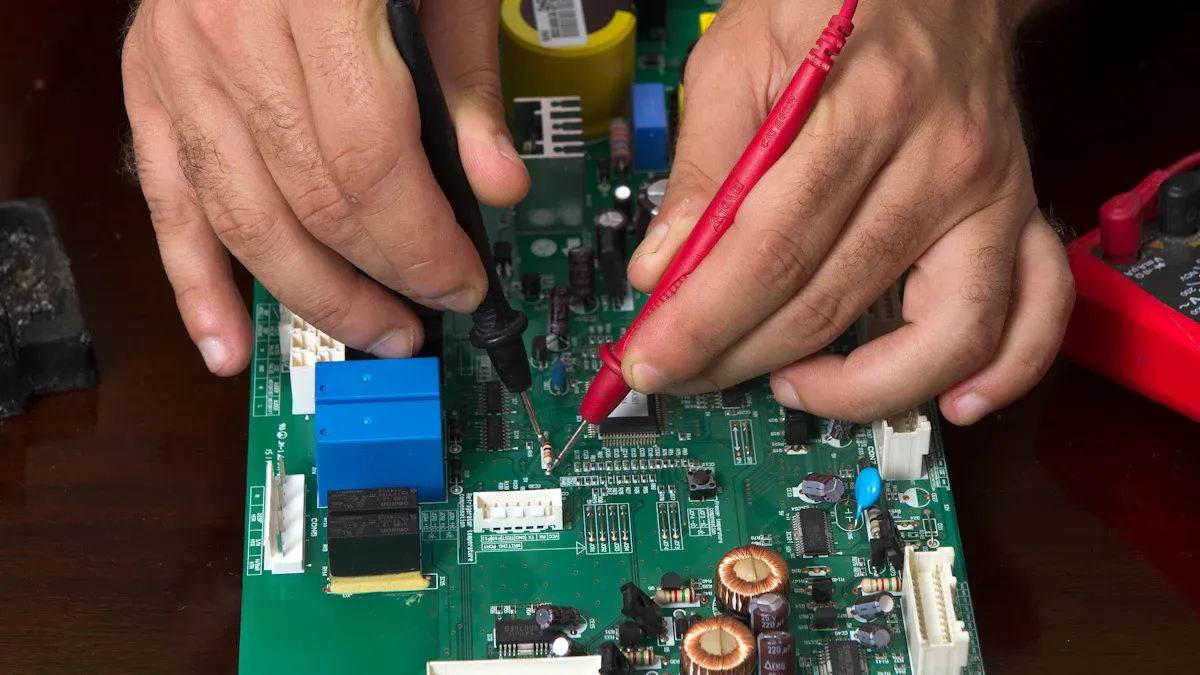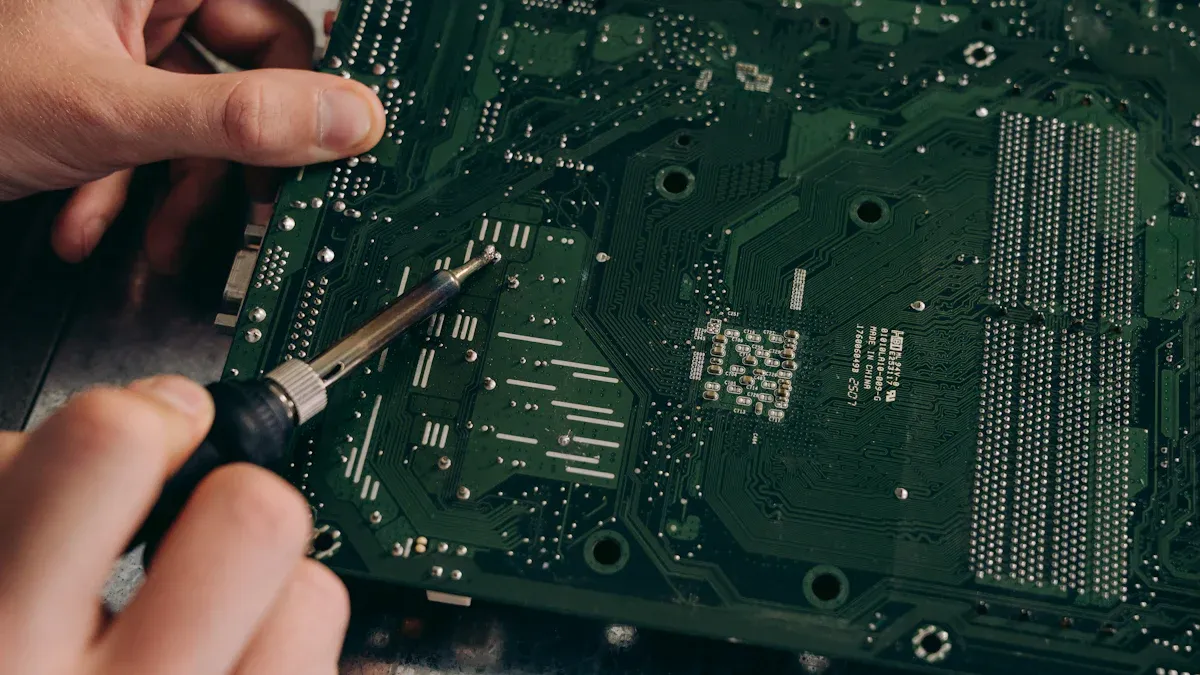Common Issues Caused by Poor Temperature Distribution in SMT Reflow Soldering

You can encounter significant issues in SMT if the temperature distribution is not even during soldering. Uneven temperature distribution can lead to problems such as solder bridging, tombstoning, voids, and warping. These issues compromise the quality of SMT work and reduce the reliability of each joint. Poor heat control during reflow negatively impacts soldering quality and weakens the strength of your assembly. LTPCBA employs advanced technology and precise temperature distribution monitoring to ensure high-quality SMT soldering with consistent results in every reflow soldering process.
Key Takeaways
Keeping the temperature even during SMT reflow soldering is very important. It helps make strong and dependable solder joints. If the heat is not even, it can cause problems. These problems include solder bridging, tombstoning, not enough solder, and parts moving out of place. Using thermal profiling tools to watch the temperature helps find problems early. It also helps keep the soldering process steady. Controlling how fast the heat goes up, how long it soaks, and the highest temperature helps stop defects. These defects include solder voids, head-in-pillow, and warping. Using smart technology and careful checks, like LTPCBA does, makes sure SMT assemblies are high-quality and last a long time.
Temperature Distribution in SMT Reflow

Having the same temperature everywhere is very important in the SMT reflow soldering process. When the PCB heats up evenly, each part gets the right amount of heat at the right time. This helps make strong solder joints and stops common problems. If the temperature is not even, you might get issues like solder bridging or not enough solder. These problems can make your assembly less reliable.
A study compared different ways to control heat in SMT reflow soldering. It showed that uneven temperature causes more soldering problems. The researchers used special methods to find out that controlling thermal mass and spreading heat evenly are needed for strong solder joints. Numbers like process window index and defects per million opportunities show that better, even temperature profiles lower defects and help you make more good products.
Note: Checking the temperature all the time in SMT reflow soldering helps you find problems early. Watching the process with many thermocouples lets you see hidden temperature changes. This way, you can fix things before defects happen. This keeps solder joints good and cuts down on wasted time and materials.
LTPCBA knows how important it is to control temperature in every part of SMT reflow. The company uses smart monitoring and real-time controls to make sure each PCB gets the best temperature during soldering. This focus on quality helps you get reliable and high-yield assemblies.
Solder Bridging
Solder bridging happens when too much solder connects two pads or leads by mistake. In SMT reflow soldering, this often happens because the temperature is not even. If one part of the PCB gets hot faster, the solder melts and moves unevenly. This can make bridges between pads that are close together.
You can stop solder bridging by keeping the temperature the same across the board. Studies show that better reflow profiles and even heating lower the risk of bridging. Watching the temperature in real time and controlling the process helps you set the oven right and avoid this problem.
Ways to help you stop solder bridging:
Keep the temperature even during reflow.
Use good solder paste and put it on carefully.
Watch the reflow process with thermal profiling tools.
LTPCBA’s machines and strict checks help you stop solder bridging. They give you exact control at every step of soldering.
Insufficient Solder
Insufficient solder is another problem in SMT reflow soldering. This happens when the solder does not cover the pad or lead well. It makes weak or bad joints. Uneven temperature during reflow is a main reason for not enough solder.
A technical study using computer tests found that uneven heat in reflow ovens causes stress and not enough solder joints. Things like conveyor speed and air flow can change the temperature, making it hard for solder to flow and stick. The study also says that bad cooling can cause cracks and weak spots inside the joint.
You can fix insufficient solder by:
Keeping the temperature even during reflow.
Watching the process with real-time data to spot problems early.
LTPCBA works hard to give you good quality with constant thermal checks and process improvements. Their advanced systems help you keep the right temperature at every step. This lowers the chance of not enough solder and other problems.
Tip: Always check your solder paste and make sure your reflow settings match your parts and PCB design. Keeping the temperature steady is the key to strong and reliable solder joints in every assembly.
Quality Issues from Poor Reflow
Tombstoning
Tombstoning is a problem in SMT soldering. It happens when one end of a small part lifts up. The part stands straight, like a tombstone. This usually happens because the temperature is not even on the PCB. If one side gets hot faster, the solder melts first on that side. Surface tension pulls the part up before the other side sticks.
You can stop tombstoning by keeping the temperature even. This is important in every step of reflow soldering. The steps are preheating, soaking, reflow, and cooling. Each step needs careful control. A good temperature profile stops sudden changes. This helps keep all parts flat and safe.
Tip: Always check your thermal profile with thermocouples or test boards. This helps you find hot or cold spots before they cause problems.
LTPCBA uses smart reflow soldering technology to keep the temperature steady. Their systems watch every step. This gives you strong, flat solder joints and better quality.
Component Misalignment
Component misalignment happens when parts move from their correct spots. This can happen during SMT soldering. Poor temperature control in the reflow oven often causes this. If the temperature changes too fast or is not even, solder paste melts at different times. This makes parts slide or twist before the solder gets hard.
Industry tests show you need a controlled Ramp-Soak-Spike temperature profile to stop misalignment. Regular thermal checks and calibration help keep the process steady. You should use Automated Optical Inspection (AOI) and X-ray checks after soldering. AOI can find missing or twisted parts with over 90% accuracy. When you use AOI, X-ray, and visual checks together, you catch almost all misalignment problems.
Steps to stop misalignment:
Keep the temperature even during all reflow steps.
Use AOI and X-ray checks after soldering.
Calibrate your oven and check thermal profiles often.
LTPCBA follows these best steps. Their focus on temperature control and checks helps you get high soldering quality and better SMT processing.
Solder Voids and Head-in-Pillow

Solder Voids
Solder voids are tiny bubbles of gas or flux inside a solder joint. These voids show up more when the temperature is not controlled well. If the reflow oven gets too hot, or heat does not spread evenly, more voids can form. Digital X-ray inspection lets you find these problems. Solder voids make the joint weaker and less reliable.
Digital radiography X-ray can find voids and poor wetting in BGA solder joints.
Tests show that peak reflow temperatures over 240°C make solder voids go up by 25-30%.
Studies say that bad ramp rates and soak times cause flux to work poorly and make oxidation, which both lead to voids.
You can lower solder voids by keeping the temperature steady. Change the ramp rate, soak time, and peak temperature to fit your board and parts. Pick the right stencil design and flux chemistry to help solder flow and fill spaces. Check the temperature often and watch the process to catch problems early.
Tip: Always use X-ray inspection after SMT soldering. This helps you find hidden voids and makes your assemblies better.
Head-in-Pillow Defects
Head-in-pillow defects happen when the solder ball and paste do not join together. This problem shows up most with BGA components. Uneven temperature makes the PCB or part bend. When this happens, the solder ball lifts off the pad and oxidation forms. The solder cannot stick to the pad, so the joint stays weak.
Research shows that bending from uneven heat is a main cause of head-in-pillow defects. High peak temperatures and fast ramp rates make this problem worse. If you keep the temperature even and avoid quick changes, you lower the risk of these defects.
Bending from uneven heat makes solder balls lose contact with pads.
Oxidation during soldering stops good wetting and joint making.
Careful control of ramp rate, peak temperature, and cooling helps stop head-in-pillow defects.
You should always watch your reflow profile and use thermal profiling tools. This helps you keep the temperature steady and stop bending. When you control the process, you make your SMT assemblies stronger and more reliable.
Warpage and Reliability
Component Warpage
Fast or uneven heating during SMT soldering can make parts bend. If you heat the board too quickly, some areas get hotter than others. This can cause parts like BGAs to lift or bend. Different materials grow at different speeds when heated. Lead-free solder melts at higher temperatures. This puts more stress on your parts. When a part bends, you might see problems like head-in-pillow. The solder joint does not form right. The part lifts up and drops back down before the solder cools.
Important facts about warpage in SMT:
Good temperature control keeps parts flat.
Lead-free solder needs more heat, which can cause warpage.
Bigger parts can bend more because of heat.
Warpage can make solder joints weak or broken.
John Thompson, a senior engineering manager, says the right temperature profile stops warpage and keeps assemblies strong. Many engineers use special software and better materials to lower these risks.
LTPCBA uses smart thermal checks and strict controls to stop warpage. Their systems watch every step to keep heating and cooling even during soldering.
Long-Term Reliability
You want your SMT assemblies to work for many years. Long-term strength depends on good temperature control in every soldering cycle. Studies show that thermal checks help parts last longer. For example, Amphenol’s research tested PCB materials for over 100,000 hours. This is much longer than normal tests. They followed rules like IEEE98 A.1 and UL746B. These rules set the standard for thermal strength.
LTPCBA follows these rules in every project. Their team uses real-time checks and regular thermal tests to keep your assemblies strong. By keeping the temperature steady and using the right profile, you lower the chance of cracks, weak joints, and early failures.
Tip: Always check your temperature profile and watch your process. This easy step helps you keep your SMT assemblies strong and long-lasting.
You must have the right temperature everywhere for good SMT reflow soldering. If you check the temperature at each step, you make soldering better and have fewer problems. Checking the heat often and watching the process helps you keep the best temperature for every SMT assembly. Doing this makes SMT work better and gives you strong solder joints. Pick a company like LTPCBA to help you get good results and control the process.
FAQ
What is the main cause of solder bridging in SMT reflow?
Solder bridging happens when your PCB does not heat evenly. When some spots get hotter, solder can move between pads. This makes connections where you do not want them. You can stop this by checking the heat with thermal profiling.
How can you reduce tombstoning during reflow soldering?
You can lower tombstoning if both sides of a part heat the same. Use a good reflow profile and check your oven often. This helps each end of the part get hot at the same time.
Why do solder voids weaken your assembly?
Solder voids are small air or flux bubbles inside joints. These gaps make the solder joint weaker. You should use X-ray checks to find voids and fix your reflow process to keep joints strong.
Tip: If you check the heat often, you can find problems before they cause defects.
How does LTPCBA ensure reliable SMT soldering?
LTPCBA uses smart tools to watch and control the temperature at every step. The team follows strict rules and checks each board with AOI and X-ray. This gives you strong and reliable solder joints every time.
See Also
The Role Of Precise Temperature Control In SMT Reflow Quality
Essential Process Criteria For Successful SMT Reflow Soldering
Step-By-Step Guide To Reflow Soldering Through-Hole Components Post SMT
Typical SMT Assembly Flaws And Effective Prevention Techniques
Why Nitrogen Reflow Soldering Matters For Automotive And PCBA
